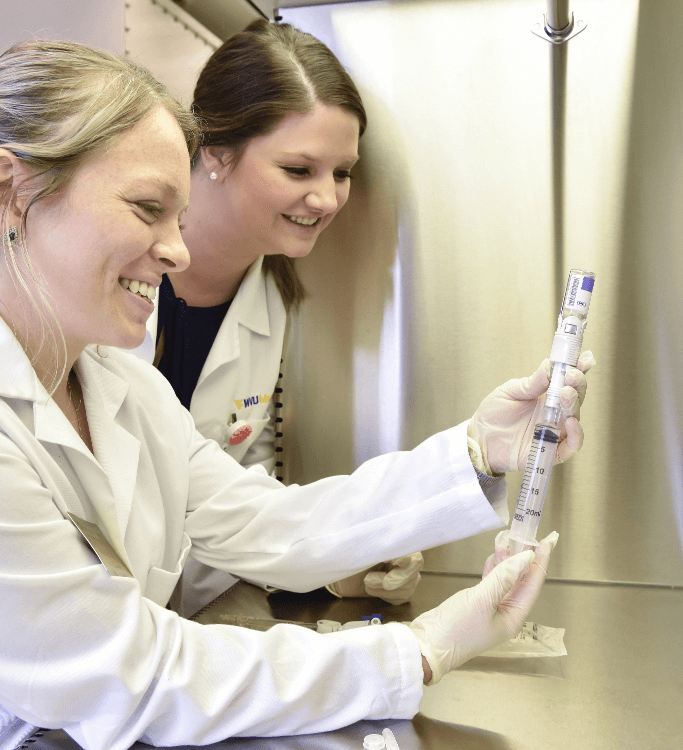A Guide to
STEM GRADUATE
PROGRAMS AND CAREERS
[Science] is more than a school subject, or the periodic table, or the properties of waves. It is an approach to the world, a critical way to understand and explore and engage with the world, and then have the capacity to change that world…”

— President Barack Obama
As you probably know, STEM stands for science, technology, engineering, and mathematics.
Innovators educated in STEM disciplines are some of the most impactful industry professionals today. Leaders in STEM have transferable, interdisciplinary experience in the hard sciences as well as extensive technical skills and research expertise. These forward-thinking, purpose-driven professionals are largely responsible for positioning the United States as the global leader it is today.
At West Virginia University, we understand the very real need for STEM education professionals. As an R1 status university, we are strategically equipped to educate the next generation of STEM leaders.
This guide’s aim is to help you understand the graduate school decision process for aspiring STEM students, debunk some common myths surrounding STEM programs, and provide you with the necessary resources you need to succeed in a STEM field.
TABLE OF
CONTENTS

MAKING THE TRANSITION TO STEM THROUGH GRADUATE SCHOOL
And how to make it smoothly
If you plan to expand your knowledge base and sharpen your skills with a STEM graduate degree — whether or not your background is in STEM or the liberal arts — you should be aware of a few key differences between undergraduate and graduate STEM programs in order to transition smoothly.
The
Application Process
Applying to graduate school is much more rigorous and rigid than undergraduate, due to the level of scholarship expected from students. An important distinction for an applicant transitioning from their undergraduate to graduate STEM program is the actual application process. Instead of an admissions team reviewing the applications, faculty members are often involved in reviewing applicants of a graduate program. This difference means that your application must focus on academic and professional achievements rather than a snappy essay and a high GPA.
The
ROLE OF RESEARCH
Research plays a much greater role in graduate school than undergraduate. In order to apply for graduate school, it is important to highlight any research opportunities you might have already had. Oftentimes, conducting your own research or supporting a professor’s research goals is the way that graduate students receive funding for their degrees.
The
COMPLETION TIME
Generally, college students can expect to finish their undergraduate studies in about four years. In graduate school, expecting a set-in-stone graduation date as a graduate student is not realistic — especially for PhD programs. Graduate school’s nebulous timeframe circles back to the research aspect of graduate studies, as research processes, graduate assistantship positions, practicums, and thesis preparation all can extend a student’s time in their program.
Understanding the
PREREQUISITES for STEM PROGRAMS
While having a liberal arts bachelor’s degree does not necessarily exclude you from pursuing a STEM graduate degree, it does depend on which STEM discipline you’d like to pursue. For instance, some programs — such as a Master of Science in Aerospace Engineering or a Master of Science in Molecular Biology — have very rigid prerequisite requirements due to the nature of the material.
However, some STEM graduate programs require applicants to hold a bachelor’s degree but do not discriminate against non-STEM bachelor’s degrees. While the below STEM programs do not require a corresponding bachelor’s degree in the same area, they might require the student to have a certain level of academic background or work experience in the subject.
Here are just a few of the STEM-focused graduate degrees that you can pursue with an unrelated bachelor’s:
Statistics
View Program PageData Analytics
View Program PagePhysics
View Program PageComputer Science
View Program PageBiology
View Program PageSoftware Engineering
View Program Page
BEST STEM DEGREES FOR THE FUTURE
If you are looking for a strong return on investment (ROI), now is an ideal time to be thinking about a graduate degree in a STEM field.
The Bureau of Labor Statistics (BLS) projects that jobs in the STEM fields will be some of the fastest growing and most profitable careers across all industries — with more than 1 million jobs being added in the 2020s.
Lucrative
STEM CAREERS
In addition to an astounding job growth rate in STEM fields, many careers in STEM are significantly lucrative. According to GetEducated.com, a source that outlines a variety of degrees and careers, there are a variety of STEM degrees that will lead to high-paying career paths — we’ll focus on five of these degrees.
Graduate degrees across the board mean an opportunity for leadership roles and a pay increase, but especially for those pursuing their graduate degree in STEM, the salary difference between disciplines proves significant.
Petroleum Engineer
Median Salary with Master’s: $111,000
Petroleum engineering is one of the most lucrative STEM degrees. Students with a background in engineering or geology would excel in this...
Petroleum Engineer
Median Salary with Master’s: $111,000
Petroleum engineering is one of the most lucrative STEM degrees. Students with a background in engineering or geology would excel in this role, as petroleum engineers seek out reservoirs of crude oil and natural gas.
Read More
View Program PageBiostatistician
Median Salary with Master’s: $73,000
Biostatistics graduates have many career avenues open to them since it's a central component ofthe public health industry.
Biostatistician
Median Salary with Master’s: $73,000
Biostatistics graduates have many career avenues open to them since it's a central component ofthe public health industry.
Read More
View Program PageMechanical Engineer
Median Salary with Master’s: $93,000
Mechanical engineering professionals are trained to design, redesign, and analyze mechanical devices. Mechanical engineering degrees not only...
Mechanical Engineer
Median Salary with Master’s: $93,000
Mechanical engineering professionals are trained to design, redesign, and analyze mechanical devices. Mechanical engineering degrees not only study the development of mechanics, but also testing and final analysis.
Read More
View Program PageEpidemiologist
Median Salary with Master’s: $69,000
Epidemiologists with their Master's in Public Health gather and analyze data to make informed judgments related to health issues. They work in a...
Epidemiologist
Median Salary with Master’s: $69,000
Epidemiologists with their Master's in Public Health gather and analyze data to make informed judgments related to health issues. They work in a variety of public health settings such as health departments, clinics, and federal agencies. Go on to earn your PhD in Public Health Sciences - Epidemiology and earn over six figures.
Read More
View Program PageComputer Network Architect
Median Salary with Master’s: $109,000
Computer scientists are responsible for envisioning, assessing, and finding solutions for new and existing computer technology systems.
Computer Network Architect
Median Salary with Master’s: $109,000
Computer scientists are responsible for envisioning, assessing, and finding solutions for new and existing computer technology systems.
Read More
View Program PageBusiness Intelligence Engineer
Median Salary with Master’s: $94,000
Business data analytics professionals are tasked with using data, technology, and analytics tools to help solve complex business...
Business Intelligence Engineer
Median Salary with Master’s: $94,000
Business data analytics professionals are tasked with using data, technology, and analytics tools to help solve complex business and operations issues.
Read More
View Program Page
STEM MYTHS YOU SHOULD IGNORE
STEM programs come with a variety of myths and misconceived notions. We examined three common STEM myths and debunked them, so you do not have to.
Myth #1
STEM programs are all more costly than non-STEM programs
Program cost depends on a variety of factors: what school you attend, the location of your program, whether you secure a graduate assistantship position, and what kind of financial aid you apply for. Depending on your personal experience and situation, a STEM program may or may not be more costly than a non-STEM program.
Thus, as you navigate the graduate school admissions process, start looking into financing graduate school to stay ahead of the game.
Myth #2
STEM professionals are not able to be creative.
Do not worry — STEM does not just consist of hours of research and dry lectures. There are plenty of STEM-related careers that require creative innovation and artistic expression.
Students can channel artistic passions into subject matter related to STEM, and there are a variety of careers that are perfect for creative minds: robotics engineer, software developer, biomedical animator, and civil engineer, to name a few.
Myth #3
You have to be really good at math and/or science to succeed in STEM.
Mathematics and science professionals have their place in the STEM field, obviously. But STEM is more about problem solving, critical thinking, and research capabilities within the hard sciences. If you’re not a math whizz or a science “nerd,” that is okay!
There are plenty of STEM-related degrees in technology and engineering that need big-picture, mission-driven thinkers.

WHY STEM STUDENTS SHOULD CHOOSE WEST VIRGINIA UNIVERSITY: AN R1 STATUS INSTITUTION
The Carnegie Foundation for the Advancement of Higher Education classifies approximately 146 U.S. institutions as having R1 status. R1 universities are at the forefront of research and innovation, and they receive federal or private funding specifically for their academic research.
R1 institutions comprise the
best research universities in the country —
AND WEST VIRGINIA UNIVERSITY IS ONE OF THEM
At R1 institutions, research study spans the academic spectrum at these universities, engaging grad students with research opportunities from the creative arts and humanities to the social sciences and applied sciences. T
here are also significant differences between R1 and R2 institutions:
- R1 institutions graduate more doctoral students than R2 institutions.
- R1 institutions receive significantly more funding than R2 institutions.
- R1 institutions produce more accomplished researchers than R2 institutions.
West Virginia University is among these R1 institutions and is well-known for its popular research-intensive programs. In fact, WVU announced in February 2022 that it had maintained its R1 status for another three years.

4 STEM GRADUATE PROGRAMS OFFERED AT WVU
As an R1 status institution, West Virginia University offers many graduate programs designed to promote rigorous academic exploration and research-based learning.
Four STEM
GRADUATE PROGRAMS
Here are four of our most popular graduate programs in STEM. Each of these represents the areas of study in the STEM acronym.
Science
Biochemistry & Molecular Biology
The Department of Biochemistry is home to the graduate program in Biochemistry and Molecular Biology. The goal of this graduate program trains students to...
Science
Biochemistry & Molecular Biology
The Department of Biochemistry is home to the graduate program in Biochemistry and Molecular Biology. The goal of this graduate program trains students to design and conduct research aimed at unraveling biochemical and molecular mechanisms controlling physiological and pathological processes. Close collaboration among scientists, the sharing of ideas, and open inquiry are critical components of our training plan.
Read More
View Program PageTechnology
Computer Science
With a graduate degree in computer science, you will thrive in a career in the growing fields of computer science and information technology. The BLS projects that...
Technology
Computer Science
With a graduate degree in computer science, you will thrive in a career in the growing fields of computer science and information technology. The BLS projects that employment opportunities in this field will grow 15 percent in the next 10 years. Combined with high average earnings of $97,000, (depending on your chosen career) this makes computer science one of the best STEM degrees for a serious ROI.
Read More
View Program PageEngineering
Civil Engineering
Civil engineering is another STEM field that is projected to experience above average earnings of $88,000, and remain on a constant path of job growth slightly above the...
Engineering
Civil Engineering
Civil engineering is another STEM field that is projected to experience above average earnings of $88,000, and remain on a constant path of job growth slightly above the national average of 7 percent. At WVU the M.S. in Civil Engineering degree aims to develop its students' abilities to use today's contemporary methods of engineering analysis and design to solve tomorrow's engineering problems. Students will receive industry-ready knowledge and skills coupled with field-relevant research.
Read More
View Program PageMath
Economics
M.S. in Economics graduates are high-level quantitative economists with the ability to analyze complex policy issues using modern data analysis and econometric methods. Graduates are...
Math
Economics
M.S. in Economics graduates are high-level quantitative economists with the ability to analyze complex policy issues using modern data analysis and econometric methods. Graduates are able to apply their learning to a large and diverse set of policy issues within our areas of program expertise, such as public finance, health economics, and regional economics. The job outlook is growing faster than average due to increasing demand for quantitative skills and critical reasoning associated with training in economics.
Read More
View Program Page
UNDERSTANDING WVU’S GRADUATE ASSISTANTSHIPS IN STEM
Graduate assistantships are a form of academic employment for which students must apply and be accepted based on academic excellence and faculty referral. Graduate assistants receive a tuition waiver based on the tasks they perform for faculty members or departments.
In addition to receiving funds, graduate assistantships are a strategic way for PhD and master’s degree students to gain practical field experience, deepen academic understanding, and network with thought leaders and students in their field.
How to Become a
GRADUATE ASSISTANT AT WEST VIRGINIA UNIVERSITY
Wondering how to become a graduate assistantship? You’re in the right place.
West Virginia University awards approximately 1,700 graduate assistantships annually to incoming and continuing graduate students. All graduate assistants must be accepted into a graduate degree program and are required to be enrolled full-time while employed during the fall and spring terms (9 credits or more).
Here are the types of graduate assistantships offered at WVU:
- Graduate teaching assistants teach courses, laboratory sections, and recitation sections, or provide other forms of instructional assistance.
- Graduate research assistants help faculty members with their research activities.
- Graduate service assistants typically work in one of the administrative or service offices of WVU in positions related to their program of study and that contribute to their educational experience.
Typically graduate assistantships work an average of 20 hours per week, while partial graduate assistants work an average of 10 hours per week as teaching, research, or service assistants.
For additional information on graduate assistantships visit the Graduate Education and Life website.
READY TO JOIN A COMMUNITY OF FUTURE STEM LEADERS? Connect With Us
Connect With Us
At West Virginia University, we understand the need for skilled, driven STEM professionals who can drive change in incredibly complex and critical industries. And you have the valuable opportunity to be a part of a community of future STEM leaders who are all working to make the world a better place, one industry at a time.
Are you ready to join the cause for STEM education? Take this opportunity to connect with us!
Connect with us and take advantage of our resources:
Start your journey at WVU today














